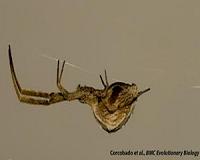| . |  |
. |
Raleigh NC (SPX) Aug 03, 2010 Scientists track amphibian populations because these animals are sensitive to changes in their environment and can serve as "canaries in the coal mine" to give researchers early warnings about pollution or other ecological problems. But new research from North Carolina State University shows that data from the largest amphibian monitoring program in the country may have flaws that, if uncorrected, could result in overestimates of frog populations. The U.S. Geological Survey launched the North American Amphibian Monitoring Program (NAAMP) in the late 1990s to collect information on the diversity and abundance of frog species. The program is important because interest in amphibian populations has grown over the past 15 years, as scientists have learned that amphibians are environmental indicators that respond very quickly to pollution and environmental degradation. "Understanding changes in amphibian populations can help us identify potential environmental problems," says Dr. Ted Simons, a professor of biology at NC State, co-author of the new study, and assistant unit leader at the U.S. Geological Survey (USGS) Cooperative Fish and Wildlife Research Unit. The NAAMP is a citizen-based program that relies on volunteers to travel to sample locations and listen for calling frogs at designated times of the year. These volunteers then report their findings, including which species are heard as well as a rough estimate of the population size, to the USGS. Simons and his co-authors wanted to test the accuracy of these surveys by using the "Bird Radio" system Simons developed previously to test the accuracy of bird census methods. The system, renamed "Ribbit Radio," consists of a series of remotely controlled playback devices that can be used to mimic populations of calling frogs. The researchers set up "Ribbit Radio" in a field and used it to test how well observers identify frog species. Simons says the researchers immediately noted a lot of "false positives" in the data - meaning that some observers were saying they heard species that were not played by the "Ribbit Radio" system. "A lot of it is human nature," Simons says. "Observers want to include as many species on their lists as possible, but sometimes our ears play tricks on us." This could be an important issue for the NAAMP, because the survey uses the presence or absence of species to monitor changes in populations. Including false positives in the analysis, if not accounted for, can produce a serious bias in these population estimates. USGS has published on how to handle false positives and false negatives in assessing amphibian occurrence data and has ongoing research in this area. Researchers hope that better training can help address this potential problem and improve the accuracy of the NAAMP in the future, Simons notes. "Training observers to help reduce false positive errors should improve the quality of the monitoring data," he says. "Dr. Simons' work adds to our understanding of observer error in frog call surveys and more research on this topic is needed," says Linda Weir, USGS NAAMP Coordinator and one of the participants in the study. Dr. Simons and NAAMP will continue working together this fall on a follow-up study using "Ribbit Radio." The current study, "Unmodeled observation error induces bias when inferring patterns and dynamics of species occurrence via aural detections," is published in the August issue of Ecology. It is co-authored by Simons, NC State's Kenneth Pollock, Larissa Bailey of Colorado State University and Brett McClintock of the University of St. Andrews. NC State's Department of Biology is part of the university's College of Agriculture and Life Sciences.
Share This Article With Planet Earth
Related Links North Carolina State University Darwin Today At TerraDaily.com
 Why Are Male Spiders Small While Females Are Giant?
Why Are Male Spiders Small While Females Are Giant?Madrid, Spain (SPX) Aug 03, 2010 'Bridging', an unusual mode of getting around frequently used by vegetation-inhabiting spiders to cross large gaps, may partly explain the tendency for male spiders to be much smaller than females. Researchers writing in the open access journal BMC Evolutionary Biology studied bridging, in which spiders use the wind to carry a strand of web to their destination and then clamber upside down ... read more |
|
| The content herein, unless otherwise known to be public domain, are Copyright 1995-2010 - SpaceDaily. AFP and UPI Wire Stories are copyright Agence France-Presse and United Press International. ESA Portal Reports are copyright European Space Agency. All NASA sourced material is public domain. Additional copyrights may apply in whole or part to other bona fide parties. Advertising does not imply endorsement,agreement or approval of any opinions, statements or information provided by SpaceDaily on any Web page published or hosted by SpaceDaily. Privacy Statement |